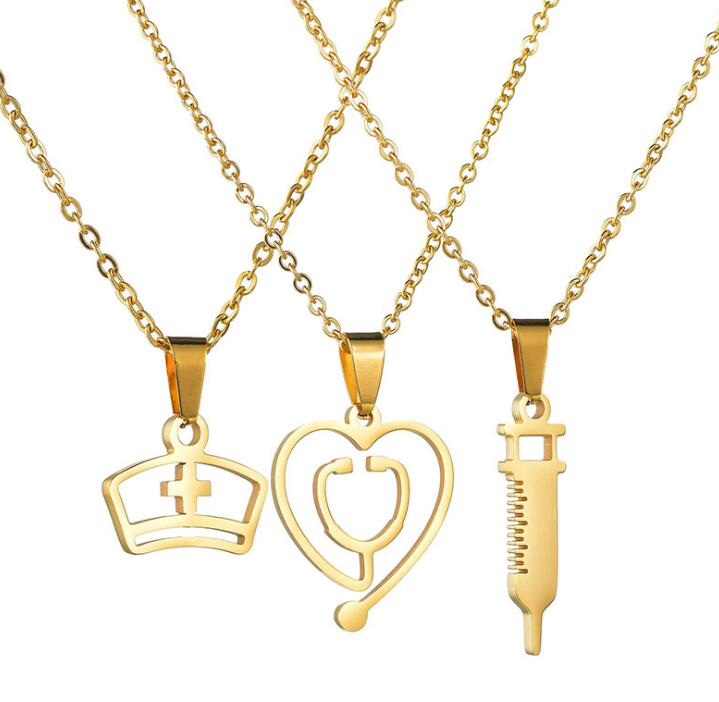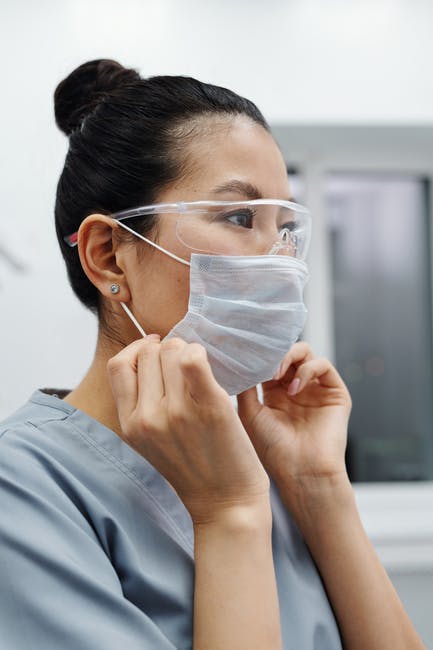Our Blog

Are you looking for the perfect way to show appreciation for the nurse in your life? Do you want to thank a nurse for all the care they gave you or a loved one? If so, you should consider purchasing different stethoscope charms and accessories. It can help them add a bit of personality and flair to their uniforms. The charms can also be tremendous conversation starters with patients that are anxious or nervous about their upcoming treatments, procedures, etc. See below for an in-depth list of cute and incredible charms and accessories that will bring a smile to your beloved nurse or doctor! 1. Caduceus Angel Necklace The Caduceus has been used as a symbol of medicine for over one hundred years. What was once the sign of the god of thieves from Greek mythology has become an insignia of hope, especially in these times we're in. Nurses are the unsung heroes of modern medicine. They're the most hands-on position in the healthcare field, and their knowledge and experience make them invaluable members of society. Think about it: any time you're out with a loved one who's a nurse, how many times have they stopped to help someone that wasn't feeling well or needed assistance? It's because they've committed their lives, not just their careers, to helping those in need. That alone makes them a living, breathing angel. What better way to celebrate their incredible bravery and kind-heartedness than with this caduceus angel necklace ? It features the caduceus symbol with wings and a red cross at the top. Both the pendant and necklace are made of 925 sterling silver. It's nickel-free, lead-free, cadmium-free, and hypoallergenic, meaning your beloved nurse can even wear it while he/she is on the job. The pendant size is 0.70 inches by 1.11 inches, making it the perfect size for nurses of any shape or size. 2. Nurses Are Angels Set Are you noticing a theme yet? We have great admiration for nurses and all of the sacrifices that they make in their personal and professional lives. Jean Watson said it best when she said, "Nurses are a unique kind. They have this insatiable need to care for others, which is both their greatest strength and fatal flaw." Christina Feist-Heilmeier adds to that by saying, "Every nurse was drawn to nursing because of a desire to care, to serve or to help." We would argue that they were called to it because of all three. We wanted to create a unique way to signify the role that nurses have in the lives of every patient they serve. Our Nurses Are Angels set embraces the thought that "Instead of sending us white-winged angels, God gave us nurses." We truly believe that. This set includes a necklace and two earrings featuring a gold wing. All the pieces are made from surgical 316L stainless steel and are entirely eco-friendly. The gold color gives it a bit of flair while remaining subtle enough to be worn on the job. Any time your nurse needs a pick-me-up, they can look at the winged pendants for inspiration. 3. Nurses Prayer Keychain Regardless of what your job is, you go into every workday expecting to see/do something you weren't expecting. However, that gets amplified with nurses. Imagine pulling up to work unaware of what awaits you that day. For all they know, they might have to fight to keep someone alive that day. They do not take caring for patients lightly, and they need a bit of help from above for guidance. You can remind them of that with our nurse prayer keychain . It's a great reminder for them to say a quick prayer before they jump out of their car to go to work. The keychain itself features a nursing cap charm, caduceus charm, and a sterling steel circle plate that reads: "Lord, guide my hands and my heart as I care for my patients today." 4. EKG Stethoscope Necklace Everyone understands the significance of a heartbeat . It's the sound of life. It can signify your health and well-being. Nurses are more appreciated than ever before, given all that they've had to endure the past few years. People want a way to express the love they have for their nurses. This EKG stethoscope necklace is the perfect way to do that. It has the outline of a heart mixed into a heartbeat line. It's made of eco-friendly materials, including a surgical 316L stainless steel pendant. It's incredibly lightweight as well, making it a great gift for working nurses on the go. 5. Rhinestone Badge Reel For those of you that are looking for a fun way to show off your nurse's personality, these rhinestone badge reels are sure to do the trick. Some of our favorites include one that reads "worlds cutest nurse" and "coffee, nurse, repeat". The reels are made of a 360-degree swivel rotation clip and 60 cm of retractable polyester cord. Most nurses are required to wear their badges at all times, so a bad reel is a great gift to help them add a bit of sparkle to their work uniform. Invest in These Stethoscope Charms and Accessories Today Now that you have seen an in-depth guide on several nursing gift ideas, such as stethoscope charms, be sure to use this information to your advantage. Take the time to read this article for more information on the stethoscope necklace and other great nursing gifts you should buy. To get started, please feel free to reach out to us by phone at 646-399-2617, and we will be happy to assist you further.

Doctors and nurses put their lives and health on the line to ensure that everyone is safe. They deserve and need to feel appreciated and valued for the sacrifices they make. Saying thank you to a nurse could have the most significant impact. And for that nurse or doctor in your life, a thoughtful gift on the National Nurse Week or their birthday can shine some light on their hearts and faces. While the profession restricts wearing jewelry , such pieces remain the best gift options. A fine piece of nurse jewelry communicates to the heart and makes for a fantastic keepsake. But how do you choose the best option, given the restrictions surrounding jewelry in this profession? This article sieved through thousands of options to give you a list of the best jewelry gifts for nurses. Read on for a chance to put a smile on the face of that hero. 1. A "Born to Be a Nurse" Necklace The "Born to Be a Nurse" EKG necklace package is one of the best gifts for nurses. It comes in a box containing a super fine and exciting necklace that your nurse will be proud to wear daily. Also, the package contains a gift card with a well-thought message to spur the inner joy in nurses. It's a piece of high-quality women's jewelry with a stylish look. Its pendant and chain are all products of the highest quality of materials to stand the test of time and style. The stainless steel on the chain ensures that the necklace will last longer and maintain its quality (no tarnishing). Also, the jewel comes in a neutral but elegant design to match every fashion and occasion. 2. A Silicone Ring The amount of wearable jewelry for nurse graduates and professionals is limited. But a silicone band is a hospital-approved piece of jewelry and a perfect gift for your engaged or married nurse, especially men. The silicone ring is durable and flexible. Thus, it allows for extreme duties and commitments at the hospital and home. Also, it's a perfect solution if you're looking for a ring that doesn't cause ring avulsion. The silicone ring's design causes it to break in the face of too much pressure. Still, it's flexible enough and suitable for those with temporary swollen fingers or large knuckles. Are you thinking of the perfect gift to present during Father’s Day, a marriage anniversary, Valentine's Day, etc.? Pick a silicone ring and give the male nurse in your life a reason to rejoice and enjoy the profession. 3. Stethoscope Pins A stethoscope is one of the essential accessories in the medical field. How about making them a part of your nurse friend or family's daily fashion? Stethoscope pins are one of the best gifts for nurses in school. It's a unique way to tell them that you acknowledge the effort they're making and their accomplishments. Both environmentally friendly and hypoallergic, these pins will be the pride of their wearer. Stethoscope pins help nurses show the world that they also care about environmental safety apart from humans. Also, these pins don't expose wearers to allergic complications. 4. A Nurse Prayer Keychain Studies indicate that feeling unappreciated and undervalued leads more nurses to stress than the pressure of the profession itself. Hospital management and doctors play a significant role in making these professionals happier and more grateful for their careers. However, you can also add some inspiration and change the whole situation with a little act of kindness. Saying thank you to that nurse in your life with a prayer keychain can make a big difference. First, it makes them feel loved, valued, and appreciated. Also, the prayer message helps them be hopeful and inspires them to keep a positive mindset. These keychains are the perfect gift for all nurses, regardless of gender. 5. Medical-Themed Stethoscope Necklace A stethoscope pendant necklace is among the best medical jewelry for nurses. A stethoscope is an essential tool for the profession, so a stethoscope necklace makes for a perfect gift to add to their daily fashion. They're elegant and stylish enough to make their wearers proud. Also, they're an excellent way to show appreciation for their hard work. The pendant necklace comes with a love sign to remind the nurse of your passion and affection towards them. It's also an excellent way to remind them of their daily sacrifices and that it all starts from their passion and love for humanity. The gift has a unique and special meaning, making it a perfect choice to give the nurse, doctor, medical staff, or student in your life. It's an ideal gift option for any occasion, including birthdays, anniversaries, graduation days, etc. For best results, pick a necklace that's nickel-, lead-, and cadmium-free. 6. Retirement Nursing Keychain While celebrating the nurse or doctor in your life, don't forget the retirees. After all, the years they dedicated to serving humanity were all valuable and worth remembering. Besides, many nurses give up the profession along the way. Retired nurses sacrificed all of their youthful days to service, and that's priceless. Thus, you need to commend their excellent work and determination. A nice retirement nursing keychain makes them feel your care. A retirement gift also reminds them of their victories over nursing challenges. If you're planning to attend a retirement party or anniversary, don't forget to carry this simple, impactful gift. The message in the keychain reminds retired nurses of the good fight they put in. Get the Best Nurse Jewelry Nurse jewelry gifts offer the best way to celebrate the nurses in your life and make them feel special. Even the nurse that cares for you at the hospital can significantly appreciate any form of "thank you" gesture. It doesn't have to be complicated, but you don't have to limit yourself either. If you can move mountains for them, then why not? Better still, a gift as simple as a keychain can go a long way. PN Accessories leads with the best gift ideas for the nurses in your life. Check out our online store to get a glimpse of our top selection of doctor, nurse, and medical student jewelry.

Nurses and other medical professionals have been hit hard by the COVID-19 pandemic . In an already understaffed profession, nurses are expected to do more with less these days. But what about those who decide to stay? Our healthcare system simply couldn't function without the brave men and women who continue to care for the sick and hospitalized. How can we say thank you! to these valuable people ? Something as simple as a nurse headband is a great start. Keep reading for some more fun (and functional) ideas. Why Wear a Nurse Headband? Cleanliness is paramount to a sterile environment. If a hospital or clinic isn't clean, bacteria and viruses can spread. Nurses with long hair or hair that falls in their eyes are at risk of contracting and potentially spreading harmful droplets through their hair. Fun and Functional These concerns were only magnified during the COVID-19 pandemic. With little known about how the virus spread initially, healthcare workers were taking all precautions necessary. In fact, healthcare workers cited fear of the unknown, stress of contagion, shortage of appropriate PPE as major stressors in a Nov 2020 Public Health Survey. In a world of things they can't control, nurses CAN control their hair. Keeping hair out of face, eyes, and patient contact is an extra step in infection control. Headbands can also catch sweat from dripping into eyes and face. Functional headbands can help nurses keep their clean environments clean. Dress for Success Headbands help nurses keep their hair out of the way while staying comfy and stylish. Nurses may not be able to choose the color of their scrubs, but they can accessorize. Prioritizing personal style can help nurses express themselves and feel good at work. Individualized style can also help patients better recognize and connect with their nurses. They may not remember each nurse's name or even exactly what they look like. But if a patient's nurse has a fun headband color, they're easier to recognize. Physical presentation matters to those around you. Individuals may not realize the way someone looks is affecting how they are viewed or treated in the workplace. Nurses don't exactly have the time to make sure their hair is in place. A headband will take one more thing (hair maintenance) off their plate. Headbands keep their hair in place so they can focus on the important aspects of their job. Materials Matter What's the point of personalized style at work if it's not comfy? Nurses need headbands that won't distract them or fall out of place. They also need materials that are soft, breathable, and comfortable. Cotton and spandex blends are best for comfort and staying in place. Try to stay away from latex and anything with grips that hit the skin. While these grippers are meant to help keep the headband in place, they may actually irritate the skin with prolonged use. Thin or Wide? While thin headbands may work for some, wider ones are more likely functional for a nurse. Wider headbands can spread across more of the head. Many times, they stay in place better. Some headbands add a twist to the top for a little extra style and comfort. Wider headbands may also catch sweat and smaller hairs from falling on a nurse's face and eyes. Button Up, Buttercup! Masks in hospitals and clinics are the new normal. This is, of course, for everyone's health and protection. Masking and double masking required of nurses can put a strain on their ears. Especially after several 12-hour shifts. Enter: headbands with buttons! Wide, comfortable headbands have strategically placed buttons behind the ears. Looping masks around these buttons saves the skin behind the ears. Not only is it saving nurses from skin irritation, but the mask and headband can also help each other stay in place. Accessories That Unite In a time when nurses are physically and emotionally exhausted, it's important to lift them up. Gifting an entire unit coordinating headbands is a great way to encourage unity. They may not be able to choose the color of their scrubs, but nurses can choose to twin with accessories. Send a Message Headbands are a great way to send a positive message. Words like faith, hope, love create a positive visual reminder to patients and coworkers. Headbands that say essential can help remind nurses and medical staff that they are important. Other Meaningful Gifts Headbands are a great gift but they're not the only option. Many nurses see coffee as one of the major food groups. Coffee mugs and gift certificates are a welcomed gift to many nurses. Jewelry Bracelets and other jewelry are also great options for nurses who like a little bit of glitz and glamour to their style. Gifts that Keep on Giving For the functional nurse, consider a unique stethoscope case . You can even have it personalized so they won't lose track of their stethoscope on the job. Have you ever seen a nurse without a badge? That's because most places require them. A fun and fancy badge holder is a wonderful gift for any nurse. If You Give a Nurse A Headband... If you give a nurse a headband, you should give them a hug to go with it! Nurses work tirelessly to take care of patients and their families. Cute headbands for nurses are a functional way to tell them you care. Cute nurse headbands for entire units or floors can also boost morale and build a team mentality. Comfortable elastic headbands for nurses can also carry important messages to encourage and lift up anyone who sees it. If you're wondering, "Can nurses wear headbands?" The answer is yes, as long as they are cute, comfortable, and functional. Find the Perfect Gift for Your Favorite Nurse Still searching for that perfect nurse gift? At Petit Nursing Accessories , we believe all nurses should look and feel like the superstars they are. Say "Thank you!" to the men and women working tirelessly to keep our world safe and healthy. Check out our selection of unique, stylish, and functional nurse gifts today. Whether it's a nurse headband, pin, gift box, your favorite nurse will appreciate your thoughtful gift. Questions? Give drop us a line, we'd love to hear from you.

The pandemic showed us how nurses and other medical professionals are everyday heroes. However, if you ask nurses, they probably won't tell you they became one because they like being heroic. Sure, the pay is good, and there's job stability, but the biggest draw is how they can make a difference in people's lives. Now, if you're a nurse or have a loved one who is one, you're also aware of the cons like losing sleep, working long shifts, and giving up lunch breaks. That's why gifts like compression socks for nurses are always a hit. Presents like these show how much you understand their struggles and want to help ease some of them. Read on to learn more about compression socks and why they make fantastic gifts for nurses. What Are Compression Socks? Also known as compression stockings, compression socks squeeze or compress the legs more than regular socks. The slight pressure helps promote blood circulation in the legs. Of course, there are many cases where compression stocks can be helpful. For example, patients with venous insufficiency, where the legs retain blood, diminishing returns to the heart, benefit from wearing them. Another instance would be on long flights. If you're prone to leg swelling and discomfort during long flights, compression socks can help reduce those symptoms. You may have also seen athletes wearing compression socks and sleeves. While there need to be more studies to support their use for improving performance, some evidence shows that compression socks could be helpful during recovery. You don't have to be an athlete, though, to enjoy wearing compression socks. Contrary to what you may have heard, compression stockings won't cut off your circulation. They're also not only for senior patients. Anyone can wear them and benefit from their use. Compression Socks for Nurses Are compression socks for nurses different from those sold in athletic stores or online? The answer is not at all. Remember, there are two types of compression stockings, graduated and anti-embolism. Most people, including nurses, use graduated ones, which could be knee-high or thigh-high. Anti-embolism socks are more for patients who are bed-bound. Their primary purpose is to help maintain circulation to prevent blood clots. Now, if you're looking for the best compression socks for nurses, you have tons of options. However, if you're treating yourself or giving some to your closest nurse friends, why not go all out? Be sure to gift them some fun compression socks for nurses , which come in various cute styles. Benefits of Compression Socks for Nurses Yes, cute compression socks for nurses are cute indeed but don't forget why you're buying or gifting them. As mentioned, nurses work long hours. They're on their feet most of the time, which means leg fatigue, muscle pain, and swelling are to be expected. The good news is they don't have to take meds to reduce these symptoms. If they use socks with at least a 15 mmHg pressure rating, they can efficiently perform their tasks without worrying about muscle fatigue and pain. Also, wearing compression stockings helps protect against DVT or deep vein thrombosis and other venous conditions. Great ones are also breathable, comfortable, and last for a good six months before needing replacement. What to Consider Before Buying It's easier to buy compression socks for yourself, but if you're giving them to friends, here's what you need to keep in mind. First, find out what compression level they're comfortable with. While compression stockings with higher pressure levels are more effective, some prefer light compression socks for nurses (around 8 to 15 mmHg), as these allow more mobility. Another factor to consider is comfort. Allergies to certain textiles are possible. If you're unsure, you can always go for lightweight fabrics. Other things to look for include length and quality. Before getting thigh-high ones, check if they will go with your loved one's medical uniform. You should also ask around if you don't know which brands are good because you might get your friend a pair that might look nice but wouldn't last for months. Beyond Compression Socks If you're new on the job and haven't been wearing compression socks for a long time, some things can help reduce leg swelling and pain. These include exercising your legs, following a low-salt diet, and resting your legs on pillows while lying down. If you're already doing these and still experience symptoms, it doesn't mean these tips aren't working, nor should you stop wearing compression socks. Some pairs need to be broken in, while others might not be the correct length for you. If you have thicker calf muscles, it's best to go with above-the-knee compression stockings. Also, as a medical professional, you would know when to seek a doctor's advice. Suppose your symptoms aren't improving despite wearing the best compression socks for nurses, plus following prevention tips. In that case, it may be time to get checked to confirm or rule out an underlying medical condition. Don't Forget Your Choice of Footwear Compression socks are amazing, but they can't do everything. It would be best to pair them with supportive shoes such as running shoes or lightweight clogs. To prevent accidents, remember to choose pairs that have slip-resistant soles. Pro tip: Keep an extra pair in your locker so that you can change halfway through your shift. After six hours, your feet would have compressed your first pair's cushioning and will no longer provide enough support. Ready to Go Compression Hosiery Shopping? Now that you know more about compression socks for nurses, are you ready to buy some for yourself or your friends? If yes, be sure to browse our shop . We also carry other nursing gear and accessories–perfect if you're still looking for more stocking stuffers. We invite you to check our blog to discover more fantastic gift ideas for nurses and other medical professionals. We also welcome any questions you may have, so please feel free to contact us .

Are you looking for a gift idea for your favorite nurse? Nurses are some of the most important people in our lives. They help us when we're sick, they teach us how to take care of ourselves, and they make sure that we have everything that we need. It's only natural to want to show them how much you appreciate all their hard work with a thoughtful gift. We've compiled a list of top gifts for nurses so you can find the perfect present this holiday season! From cute socks and slippers to fun games and puzzles, there is something on this list for everyone. And if none of these gifts strike your fancy, don't worry - just check out our helpful links below for more gift ideas. Keep reading to learn more. When to Give A Nurse Gift Nurses work long and sometimes unpredictable hours. If you're not sure when your nurse is working, the best time to give them a gift is right before or on their birthday. If they aren't at work, most nurses will appreciate getting a present at any time of year. Who Should Give A Nurse Gift? Anyone! Nurses are very kind and give to other people, so they will appreciate any thoughtful gift that you give them. While nurses can receive presents from patients, family members, friends, or even coworkers, the most common giver is likely to be their significant other. How Much Should A Nurse Gift Cost? While there is no set price for gifts for nurses, most people spend anywhere from $10-$50 on each nurse that they give a gift to (unless it is their significant other or the nurse is very close with you, then more money is not an issue). Some gifts are free of charge. Here are some of our favorite gift ideas: 1. Slippers Any nurse will appreciate cute and functional slippers when they get home from work. There are many different styles to choose from, so you can find the perfect pair at a price point that is right for your budget. You could even make them yourself if you wanted, with an inexpensive pattern and some fuzzy fabric. This is great because slippers are a practical gift that any nurse will use regularly. They'll love having warm, fuzzy feet every time they go home from work! 2. Socks Slippers aren't the only footwear that nurses will enjoy. Socks are another gift that nurses can always use because they're usually on their feet all day and need to relax when they get home. You should never underestimate the power of good socks; it's one of the best gifts you can give. And it doubles as a practical and cute gift, so win-win. 3. Coffee Mugs Nurses drink a lot of coffee throughout their workday, so why not encourage them by giving them a cup that reminds them how much they're appreciated? Most workplaces have a "bring your mug" policy, so they'll be able to take it home with them. And this is another gift that can double as a cute and practical item. 4. Phone Cases Some nurses have to use their phones in the workplace, so why not give them a customized case to show off their profession? There are many different styles to choose from, so you can get something that appeals to your nurse's tastes. It'll keep their phone safe and make a great conversation piece. These can be pricey, but a phone case is a gift that one can personalize to fit any budget. They're also great for all of the nurses on your list! 5. Tote Bags Many nurses have a lot of things to carry when they're at work, so why not find them a bag that will keep their belongings safe? There are many different styles to choose from. Some bags even have compartments specifically designed for stethoscopes and other medical equipment! This is a great gift for any nurse since they will use it every single day. You'll be giving them something that will make their life easier, which is always appreciated! 6. Puzzles Puzzles are an excellent way to pass the time during long breaks, and nurses need some downtime! There are many different options to choose from, so you can find the perfect one for your nurse. These puzzles are great for nurses of any age, so you can find something that will appeal to everyone on your list. 7. Coffee Makers Coffee is essential to staying awake on long shifts, which is why some nurses rely on coffee makers that they bring into the workplace with them. You can give them a caffeine boost that they can use in the workplace by giving them an excellent coffee maker. Nurses love this because they get to drink good coffee while they're at work. 8. Gifts Cards Sometimes, nurses simply need to take a break and take care of themselves, so why not encourage them with gift cards? You can find gift cards for restaurants, movies, or even workout classes! You might think these are impersonal, but it's always great to give a gift card in case the nurse on your list doesn't have anything he or she wants or needs. You can use it in place of any other item, so what could be more perfect? 9. Recipe Books Some nurses struggle to find time for themselves, even in their own free time. Why not give them a recipe book so they can cook delicious food when they get home? They'll be able to relax after work and enjoy some much-needed downtime. 10. Nurse-Themed Jewelry There are many jewelry options that feature classic nurse symbols, such as a stethoscope or a heart. You're sure to find something at the right price point for you. These can be really cute gifts. These can be great because they double as a cute gift for the nurse on your list. And some of them are fairly inexpensive, so you can find something that fits within your budget. Buy The Perfect Gifts For Nurses The perfect gifts for nurses don't have to be hard to find! There are many options available that will work with any budget, and there's sure to be something that appeals to your nurse's personality. By giving the nurses on your list a special gift, you'll be letting them know how much you appreciate all of their hard work! Finding a present for a nurse can be easy--you just have to find the right present for the right person! Start your search by looking here.

Inspirational badge reels, cute surgical hats, and handy cases: they're all a part of the nursing dream. While all nurses look forward to taking care of their patients, there are a few things that can help the day go even smoother. No matter what's on your plate, the right nursing accessories can help you get through a tough shift. That's why we're here. We're going to lay out the top nurse accessories that you need to get through your next shift. This nurse accessories guide could be the key to getting your love for nursing back. 1. Badge Reel The badge reel is a nursing essential. Obviously, you'll need one for your ID badge. But, it does so much more. A nurse's badge reel says a lot about their personality. It could be a brand that you resonate with, the hospital you work at, a motivational quote, or a funny tidbit. No matter what you choose, the badge reel that you wear should reflect who you are. Luckily, there are plenty of badge reels to choose from . So, you can find the perfect one for you. You could even have one for different days of the week or different job tasks. Whenever your patients and their families see your badge reel, you're likely to get comments and compliments. There's nothing better than seeing that your nurse is relatable. And, this connection that you make could better your relationship with the patient and their overall care in the hospital. 2. Protective Eyewear When things go splashing, you need something to protect your eyes. That's why we suggest investing in protective eyewear. The plastic extensions on facemasks just aren't enough. In fact, they bend and rip easily. So, you may end up not being protected anyways. Having your own pair of glasses can keep your eyes protected at all times, even during those times in which you didn't think to grab an eye mask. Plus, there's no fighting over eye masks when you have your own pair of protective eyewear. You can protect yourself with your reusable pair of protection. 3. Headband We all know that one nurse who ended up landing her hair into something nasty. It may have been a wound, a pile of poop, or something else. We never want that to happen to us, right? That's why you need a headband to catch those extra hairs that your hair tie didn't catch. A headband can save you a trip to the community shower in the basement, not to mention the disgusting feeling of something hanging in your hair. Ew! Just like your badge reel, your headband can show some personality. You can even personalize them a little bit. One of our favorites is the headband with buttons . We all know how uncomfortable it can be wearing those masks all day. The buttons on these headbands can help hold the mask strings away from your ears. 4. Surgical Hat If you're looking for something to protect all of your hair, we have the perfect accessory: a cotton surgical hat. These comfortable, full-protection caps will keep your hair out of anything and everything that it may find its way into. Plus, it's great for those nurses who are working in environments with neutropenic patients. Whether you're in the ER, the OR, the ICU, or somewhere else, these surgical caps will keep your hair sparkling clean. You won't have to worry about hitting the showers. And, your hair will look exactly the way it looked when you walked into work. You could even change out your scrubs to meet someone for breakfast or dinner after your shift. The best part about these surgical caps is that you don't have to worry about having to use the ugly, paper caps that the hospital provides. You can choose your own pattern or color to wear. You could even coordinate with your color of scrubs. 5. Stethoscope Case Nurses have to carry around a lot. From their stethoscope and their penlights to their pens and their trauma shears, nurses are equipped. Even with 50 scrub pockets, all of these supplies can be too much. That's why every nurse needs a stethoscope case . Despite the name, these organizers can carry more than just your stethoscope. In fact, you'll find that they can carry all of those pesky supplies that you don't necessarily need with you all of the time. 6. Rechargeable Penlights Whether you're looking at your patient's pupils or their pharynx, you need a good penlight. However, most nurses get stuck in a bad position when their penlight suddenly runs out of battery. Unless you're going to run across the hospital looking for the last pair of batteries, you aren't likely to find the ones that you need right when you need them. That's why you should invest in bright, rechargeable penlights . You'll be able to recharge them without needing to keep buying more batteries. Plus, you could always have a second one on hand if one were to run out of battery. 7. Compression Socks Our last selection in our nurse accessories guide is the holy grail for nursing: compression socks. None of us want varicose veins. None of us want pitting edema. And, we all know that none of us ever want to feel the weight of a 12-hour shift on our feet. That's why each and every single nurse needs a pair of compression socks . If you haven't experienced the magic that is compression socks, you need to give them a try as soon as possible. Your legs and feet will thank you. There are so many advantages of wearing compression socks. Get All the Nurse Accessories You Need That's it! You've made it to the end! Now that you've reviewed all of the essential nurse accessories, it's time to go shopping. And, there's no better place to get your nursing accessories than Petit Nursing Accessories. We have everything on this list and more. Check out our store to see what kind of goodies you can get yourself. You deserve it, hero.

You've taken all of the steps to become a children's pediatrician, yet you're struggling to really get to know your patients and form the relationships you've always wanted on the job. You've learned all of the doctor lingo, undergone the stress of the job, and worked long hours. Yet, still no reward for working with kids. So how can you change this? Working with kids isn't easy and it takes a very specific demeanor and way of talking to them to get them to warm up to you! Ready for the challenge? Keep reading for some great tips on how to be the best children's pediatrician you can be! Dress to Impress You can easily throw on your nursing gear and walk into the clinic for the day. You'll be comfortable and ready to go with whatever the job throws your way. But are you really going to make an impact on the kids you are working with? Probably not. Instead, you could get attention with fun jewelry! You'll no longer be dreading your days of awkward conversation starters and prying kids to talk to you. They'll be eager to know about your jewelry and your outfits. Whether you choose to wear just a fashionable headband or also throw on your adorable ID holder, your patients will be asking all about your style! Understand What Kids Are Into These Days As the generations change, so do the activities and hobbies that kids are into. In order to communicate with your patients, you will want to be up-to-date with the times! If you bring up what you loved as a kid, like the Fresh Prince of Bellair or the Rugrats, they'll look at you as if you're not even there. They have no idea what those things are! Instead, you need to be reading articles, watching TikToks, and scrolling Instagram to understand what kids love right now. Once you hear some lingo you haven't heard before, it's time to do some research! For starters, here are a few examples of what you may need to learn more about to connect with your patients: Snapchat The Lego Movie Minecraft Among Us Fortnite Beyonce These are just a few of the things you may be able to talk about with your patients! But in reality, you need to get to know them at an individual level. They may tell you that they like basketball or gymnastics. Maybe they are really into chocolate ice cream. Or maybe they want to tell you about their friends. Once you have that common ground, you can hold conversations with them all about what they love! Give Choices Most of the time, kids are not the best at being told what to do . Since that's the case, you can win them over by giving them choices and being open to different options. For instance, if you are about to give your patient a shot, ask them where they want to sit! Or if you want to give them a lollipop, ask them what flavor is their favorite! Even this small level of autonomy will make them feel more comfortable with you. Less Is More You've probably seen it before. Three nurses walk into your room, and you start to panic. It's three against one. Imagine being a child when this happens. It would be extremely overwhelming to have a ton of nurses in the room (especially if there is no reason for it). The child will respond better if they trust the doctor and have a relationship with them. Therefore, keeping things consistent with just one pediatrician (you) will lead to better results. Use Distractions When it comes to working with kids, providing distractions is a great way to keep them smiling and distracted from what is actually happening. Putting a TV or music in the patient's room will allow for distractions with noise. Instead of hearing all of the instruments and supplies surrounding them, they are able to focus on their favorite TV show. Or maybe you have to give them a shot. While you do this, give them a toy to play with. This could be anything that will keep their interest and attention for a few seconds. Let Your Patients Help You Children love to be helpers! They love to feel as if they have a role in whatever you are doing, so to build trust with your patients, allow them to help you out. You may be wondering how to do that in a medical scenario. Well, if you are about to give a shot, you may ask them to hold the bandaid before you open it. Or maybe you tell them to hold your stethoscope while you are not using it. Not only will they feel like they are helping, but they will be very interested and distracted by the medical supplies you are having them engage with. You Need These If You Are a Children's Pediatrician Working with kids can be one of the most rewarding experiences if you do it right. If things aren't clicking with the kids you work with, there are so many things you can do to improve your relationship with them! Get to know their interests, build trust, give them autonomy, and find some common ground. If you are ready to change how you interact with your kids, check out our shop for some adorable products that your patients will love to see on you, like this pink ribbon brooch !

Have you ever rolled out of bed and started working at your computer only to realize you are not being productive? You find yourself scrolling on Instagram and reading news stories on Facebook instead. What about the days where you workout and then get ready for the day – makeup, a cute dress, and a bun on top of your head to top it all off? What do you notice then? You probably realize that you are being more productive, getting more done, and are overall having a better day. But why? Because what you wear has a direct impact on your mood and your actions! So what does this mean for your everyday life? Keep reading to learn more about how what you wear affects not only yourself but others too! "Dressing for Success" Can Help You Feel Confident Getting dressed up in formal clothes can actually change your mindset. That's what they mean when they say you should "dress for success." When you do this, you are setting yourself up for success because you are going into a situation with more confidence. Whether you are dressing up for a golf outing with your best golf skirt and top or heading to your dream job interview in the most formal dress you could find, dressing for success will scientifically change your mindset. Your body will release more hormones because you are feeling good about yourself. You are then attracting good things to happen to you, and therefore, you will be more successful. Comfy Clothes Help You Relax We're sure you've heard of casual Fridays. Everyone loves them. But why? It changes your mindset! You are more likely to be friendly with your coworkers, and you're probably happier because you get a break from the "norm" that you have to conform to at work. Not only that, but you may feel more relaxed. A lot of times, feeling more relaxed will lead to more productivity in the workplace. Wearing Colorful Jewelry Can Change Your Mindset Have you ever looked outside and seen that it was a rainy, gloomy day, and thought that you should brighten your mood with a fun outfit and fun jewelry? Well, it can change your mindset when you wear fun jewelry. It can change your mood and mindset, even more, when you wear fun jewelry from other people. When you put it on, you'll automatically think of the loved one who gave it to you and be transported to happy times. If you bought jewelry in another country or on a vacation, you'll also get a little boost from that memory as you put them on. With the thought of old memories and loved ones, we also feel more empowered with jewelry. We feel done up, ready to go, and ready to face the day ahead of us. Clothing Can Show Your Individuality People say that what you wear shows a lot about you. For instance, if you wear a baggy pair of sweatpants and a sweatshirt to homecoming, that probably shows you don't care very much about the event. If you choose to wear a pantsuit to your job as a realtor, you are demonstrating your professionalism. It goes further than that, too! Even the littlest deviations from the norm can give us something unique about ourselves. If you choose to dress fun even when you are given a uniform, that probably says that you like to live outside of the box or have a little more fun. If you are a nurse, you most likely wear scrubs to work, but you can add a fun headband or a more unique ID badge than the one the hospital or doctor's office gives you! Every little decision you make about your wardrobe and outfit selection shows off your individuality! Hidden Garments Affect Your Mindset, Too You may not have thought that what you wear underneath (aka, your underwear, socks, and bra) actually affects your mood as well. But it does! Wearing fun socks can help us feel a little more quirky or outgoing. Wearing a pair of professional socks can help us feel more professional. If we put on a sexy pair of lingerie, we feel sexier and more empowered. Our subconscious is aware of what we are wearing and how it makes us feel, and that is translated to everything we do and the decisions that we make. Everyone has a different perception of what is sexy or not, but it matters only to you since you are the only one who knows when you are out and about. If you're wearing a matching lingerie set, you may even feel more put together and ready for the day. What You Wear Affects You and Others Now that you actually know that what you wear affects yourself and others, everything you've ever felt before in regards to clothing probably makes sense! You feel better and more confident when you dress up, and you feel more relaxed when you put on some workout clothes or sweatpants. You may feel naked without earrings, but when you add the perfect set, your world lights up just a little bit. If you want to wear fun jewelry to work and have fun with work outfits to change your mindset, check out some of our options on our online shop ! You'll not only look like a pro at your job but feel like a pro, too.

Did you know that there are around 3.8 million nurses in the United States? Nursing is a rewarding career that allows someone to help other people, make a difference in the world, and have plenty of job opportunities. If you have a loved one that is currently in nursing school, you should be proud of their hard work and accomplishments. One of the best ways to show your loved ones that you care about them is to get them some new nursing gear. Many new nurses are nervous to start working as a nurse, but having the right medical accessories can help calm their nerves. What are some of the best gifts for a nursing student? Keep reading to find out! Scrubs One of the most important things that all healthcare workers need is scrubs. Your nursing student will wear scrubs to work every day, so they are a gift that they will use. Certain scrubs help keep nurses cool during the day, some have a stylish fit, and some are super comfortable. Nurses often work long shifts, so comfort is essential. Before buying scrubs for your nursing student, check to see if they need specific colors or styles. Some nursing programs and jobs require their nurses to wear certain scrubs. Stethoscopes Another great gift to get the nursing student in your life is a stethoscope. Having a stethoscope is a must in the nursing field as it allows a nurse to learn a lot about a patient's condition. With a stethoscope, a nurse can tell if a patient is having lung or heart problems . Many stethoscopes come with the option to get different colors, designs, and patterns. You may even be able to get the stethoscope engraved, which will prevent mixing it up with other people's stethoscopes. Blood Pressure Cuffs Like a stethoscope, blood pressure cuffs are essential nursing supplies that your nursing student will need. While most hospitals have blood pressure machines, nursing students may need to take someone's blood pressure on the go. There are several different types of blood pressure cuffs, so ask your nursing student before buying. You may even be able to find a set that has both blood pressure cuffs and a stethoscope. Compression Socks Nurses work on their feet for long shifts, so compression socks are a great gift idea. Many nurses end up developing varicose veins, blood clots, or have pain in their feet. Varicose veins are veins that are enlarged, twisted, and uncomfortable. They mainly show up in the legs, and they are common for nurses because they stand all day. Thankfully, compression socks can help prevent them. In addition to preventing issues with blood flow, compression socks can also help relieve the pain that nurses feel after standing all day. Having foot pain can make the workday long and unbearable. Lab Coats Another one of the best nursing accessories to get your nursing student is a lab coat. During nursing school, they will have to wear lab coats to labs, meetings, and other important events. While they may not wear their lab coat much after nursing school, it will still come in handy. Many nurses wear a lab coat over their scrubs to keep them warm in the winter Some benefits to wearing a lab coat are that they look professional, and your nursing student will have more space to store their nursing supplies. Penlights If you want to get the nursing student in your life something they will always use, you should get them a penlight. Penlights are helpful in many different situations in the nursing field. A nurse can use a penlight to check someone's neuro status, mucus membranes, and wounds. Penlights, are small, convenient, and easily fit in a nurse's pocket. Even if the nursing student in your life has penlights, it never hurts to have more. Try getting them a rechargeable penlight. Nursing Shoes Like compression socks, having good shoes is essential for a nurse's feet. While it may take some time for nursing students to find the perfect pair of shoes, they should start trying different shoes. Being on your feet for 12 hours a day with the wrong shoes can lead to foot, knee, and back pain. The right shoes should alleviate these pains as much as possible. Nursing shoes come in all different styles, textures, and colors, so you can find the perfect look for your nursing student. You can choose from clog-style shoes, tennis shoes, or slip-on shoes. Watch Because nurses work long shifts, they need a watch to keep track of time. Time management is important as a nurse because you need to make sure patients get the care they need on time. If you have the budget, you should consider getting your nursing student a smartwatch. Smartwatches allow nurses to set timers, reminders, and even create a daily schedule. Because nurses are on their feet all day, it will be fun for them to keep track of how many steps they take. Some smartwatches have helpful health features, such as deep breathing exercises and reminders to drink water. Tote Bag/Backpack Nurses have a ton of supplies that they use every day, so they need a tote bag or backpack to carry all their stuff. If you aren't comfortable picking out stethoscopes, shoes, or blood pressure cuffs, a bag is a great gift option. When choosing a bag for a nursing student, be sure to keep their style in mind. Some of the best nursing bags are professional, spacious, and have plenty of pockets. If you want, you can even get them a matching lunch box. Are You Ready to Gift These Medical Accessories? Going through nursing school is a big accomplishment, so showing your loved ones that you are proud of them is important. When looking for gifts for a nursing student in your life, keep these medical accessories in mind! Are you reading to find the perfect nursing student gift? If so, check out our online store to find everything your nursing student needs.

Did you know that nursing is the nation's largest healthcare profession ? There are over 3.8 million registered nurses nationwide, with 84.5% of those registered currently employed as nurses. The federal government has projected up to 200,000 new nurse positions created each year until 2026. What does this mean for you? You probably know a nurse, or two, or three in your life—somebody whose life's work is caring for others. Healthcare workers are some of the most courageous, compassionate individuals, making holidays or birthdays an important opportunity to display gratitude, appreciation, and respect. That being said, what are the best nurse gifts out there? We've curated a list of special items that'll truly touch the nurse in your life. Keep reading. Lend a Helping Hand With a Nurse-Inspired Headband Nurses are allowed to have longer hair, but many facilities require it to be tied back or pulled up . The reason for this rule makes sense—long hair can get in the way of important tasks like adjusting IVs, helping patients sit up, or assisting in any type of emergency. The less that's in their way, the better. That's why a headband, or even a surgical hat , is a perfect gift for any nurse you know with luscious locks. Something that's specific for nurses is even better as it stands out from your average. Consider ones that have a healthcare worker theme, like EKG patterns, messages like Essential or Nurse, or stethoscopes shaped like hearts. Gift Them an ID Reel That Makes You Think of Them Every nurse wears an ID badge , which means that every nurse probably has several ID reels—and could use another. After all, they might get lost, or break, or get replaced after a long time of use. Nurses know it's never a bad idea to have extra ID reels in hand, and one that's special or unique is even better. Nurses don't have many ways to stand out with their uniforms, so little accessories like this go a long way. Any Nurse-Themed Jewelry Is Always a Good Idea There's no lack of nursed-theme jewelry out there, so you're able to choose something that's fitting for your loved one. If they like to wear jewelry at work but aren't comfortable with bracelets (for the same reasons as untied hair), consider something like an EKG rhythm necklace and earrings set that's subtle but statement-making. Other fun yet stylish options include a syringe necklace, nurse hat pendant necklace, or heartbeat necklace set. Each one says, "I'm a nurse!" in an understated way. Of course, your nurse friend or family member isn't always at work, so you could also gift a nurse-themed bracelet if that's something you think they'd enjoy. Or, you could get something meant to keep them safe on the job, like an evil eye bracelet. "Evil eyes" are meant to protect and bring good luck. Unique AirPod Cases Are All the Rage These days, so many people have AirPods. They're the go-to accessory for many a person—and every AirPod case looks the same. If your loved one has a set of AirPods they use constantly, consider gifting them with an AirPod case that no one else on their floor has. The next time they walk into the hospital as they're tugging their headphones out of their ears, they'll rest assured knowing none of their coworkers can mix up their case with another staff members'. Options include cases with phrases like, "I am a mom and a nurse—nothing scares me," or heartbeat rhythms and the like. Offer a Daily Reminder With a Personal Keychain One sure way to get daily use out of a gift is to offer someone a quirky and thoughtful keychain. By having their keys close at hand as they drive to work, school, or events, you'll always be on their mind. If they're a fan of being extra, consider getting a keychain with a collection of pendants, such as a syringe, nursing cap, stethoscope, etc. For your more minimal friend, get a subtle keychain that features just one unique pendant so as not to overwhelm their keyring. A Brooch for Your Friend That Loves Pins Another option for the jewelry lover and nurse in your life is brooches. Brooches are decorative pins that act as jewelry and typically get pinned on the chest. They're the perfect statement maker for anyone who wears a coat often, like a nurse's coat— a brooch looks perfect near the collar line. Your nurse friend could also get away with wearing the pin at work if it's subtle or out of the way. Help Them Survive a Shift With a Multipurpose Bag Many nurses like to pack some essentials before they step in for a 12-hour shift. That multipurpose bag can include things like lunch or snacks, a small water bottle, any medications, hand sanitizer, a spare headband, or pair of socks, you name it. Whatever they need to get through a night or day serving others will make its way into this bag. Offer them a place to store it all with a multiuse bag. This gift idea is also great for the practical person in your life, as they'll love something utilitarian. By giving them something useful, they'll know you appreciate their gift-receiving style. Nurses Are Vital: Say Thanks With Nurse Gifts Nursing students, practicing RNs, and retired nurses alike will love these tokens of your appreciation. These nurse gifts are sure to reflect the gratitude you have for the special nurse(s) in your life—and serve as a reminder to them of the importance and nobility of their job. The best part is you can buy one for every occasion: their birthday, Christmas, National Nurses Day, you name it. Click here to browse our nurse-inspired accessories, sure to bring a smile to the face of any nurse you know and love. Petit Nursing Accessories is a one-stop-shop for all the best gifts for healthcare workers.

